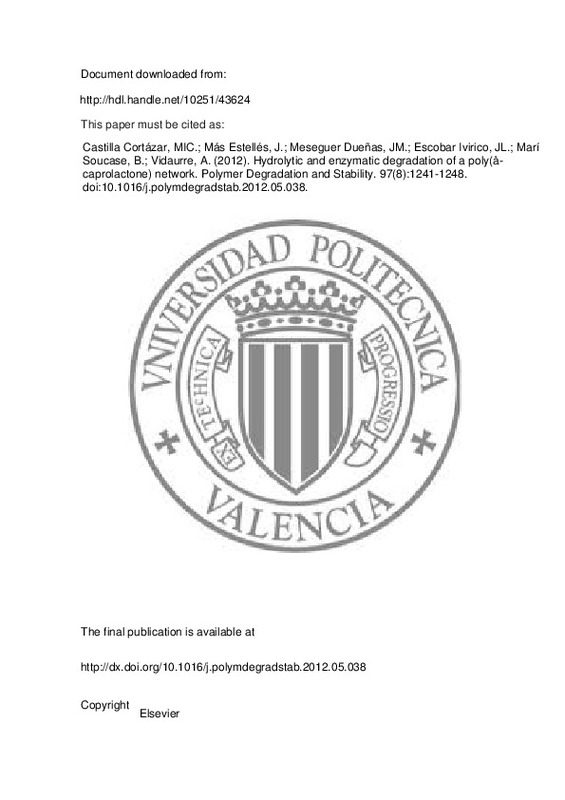JavaScript is disabled for your browser. Some features of this site may not work without it.
Buscar en RiuNet
Listar
Mi cuenta
Estadísticas
Ayuda RiuNet
Admin. UPV
Hydrolytic and enzymatic degradation of a poly(å-caprolactone) network
Mostrar el registro sencillo del ítem
Ficheros en el ítem
| dc.contributor.author | Castilla Cortázar, María Isabel Cecilia
|
es_ES |
| dc.contributor.author | Más Estellés, Jorge
|
es_ES |
| dc.contributor.author | Meseguer Dueñas, José María
|
es_ES |
| dc.contributor.author | Escobar Ivirico, Jorge Luis
|
es_ES |
| dc.contributor.author | Marí Soucase, Bernabé
|
es_ES |
| dc.contributor.author | Vidaurre, Ana
|
es_ES |
| dc.date.accessioned | 2014-10-27T19:04:16Z | |
| dc.date.available | 2014-10-27T19:04:16Z | |
| dc.date.issued | 2012-08 | |
| dc.identifier.issn | 0141-3910 | |
| dc.identifier.uri | http://hdl.handle.net/10251/43624 | |
| dc.description | “NOTICE: this is the author’s version of a work that was accepted for publication in Polymer Degradation and Stability. Changes resulting from the publishing process, such as peer review, editing, corrections, structural formatting, and other quality control mechanisms may not be reflected in this document. Changes may have been made to this work since it was submitted for publication. A definitive version was subsequently published in Polymer Degradation and Stability, [Volume 97, Issue 8, August 2012, Pages 1241–1248] DOI 10.1016/j.polymdegradstab.2012.05.038 | es_ES |
| dc.description.abstract | Long-term hydrolytic and enzymatic degradation profiles of poly(å-caprolactone) (PCL) networks were obtained. The hydrolytic degradation studies were performed in water and phosphate buffer solution (PBS) for 65 weeks. In this case, the degradation rate of PCL networks was faster than previous results in the literature on linear PCL, reaching a weight loss of around 20% in 60 weeks after immersing the samples either in water or in PBS conditions. The enzymatic degradation rate in Pseudomonas Lipase for 14 weeks was also studied, with the conclusion that the degradation profile of PCL networks is lower than for linear PCL, also reaching a 20% weight loss. The weight lost, degree of swelling, and calorimetric and mechanical properties were obtained as a function of degradation time. Furthermore, the morphological changes in the samples were studied carefully through electron microscopy and crystal size through X-ray diffraction. The changes in some properties over the degradation period such as crystallinity, crystal size and Young¿s modulus were smaller in the case of enzymatic studies, highlighting differences in the degradation mechanism in the two studies, hydrolytic and enzymatic. | es_ES |
| dc.description.sponsorship | The authors would like to acknowledge the support of the Spanish Ministry of Science and Education through the DPI2010-20399-004-03 project. JM Meseguer-Duenas and A Vidaurre also would like to acknowledge the support of the CIBER-BBN, an initiative funded by the VI National R&D&i Plan 2008-2011, Iniciativa Ingenio 2010, Consolider Program, CIBER Actions and financed by the Instituto de Salud Carlos III with assistance from the European Regional Development Fund. The translation of this paper was funded by the Universidad Politecnica de Valencia, Spain | en_EN |
| dc.language | Inglés | es_ES |
| dc.publisher | Elsevier | es_ES |
| dc.relation.ispartof | Polymer Degradation and Stability | es_ES |
| dc.rights | Reserva de todos los derechos | es_ES |
| dc.subject | PCL | es_ES |
| dc.subject | Hydrolytic | es_ES |
| dc.subject | Enzymatic | es_ES |
| dc.subject | Degradation | es_ES |
| dc.subject | Hydrolysis | es_ES |
| dc.subject | Network | es_ES |
| dc.subject.classification | FISICA APLICADA | es_ES |
| dc.title | Hydrolytic and enzymatic degradation of a poly(å-caprolactone) network | es_ES |
| dc.type | Artículo | es_ES |
| dc.identifier.doi | 10.1016/j.polymdegradstab.2012.05.038 | |
| dc.relation.projectID | info:eu-repo/grantAgreement/MICINN//DPI2010-20399-C04-03/ES/DISEÑO Y FABRICACION DE UNA PLATAFORMA BIOMIMETICA TIPO SCAFFOLD%2FSOPORTE PARA LA REGENERACION DEL CARTILAGO ARTICULAR/ | es_ES |
| dc.rights.accessRights | Abierto | es_ES |
| dc.contributor.affiliation | Universitat Politècnica de València. Departamento de Física Aplicada - Departament de Física Aplicada | es_ES |
| dc.description.bibliographicCitation | Castilla Cortázar, MIC.; Más Estellés, J.; Meseguer Dueñas, JM.; Escobar Ivirico, JL.; Marí Soucase, B.; Vidaurre, A. (2012). Hydrolytic and enzymatic degradation of a poly(å-caprolactone) network. Polymer Degradation and Stability. 97(8):1241-1248. https://doi.org/10.1016/j.polymdegradstab.2012.05.038 | es_ES |
| dc.description.accrualMethod | S | es_ES |
| dc.relation.publisherversion | http://dx.doi.org/10.1016/j.polymdegradstab.2012.05.038 | es_ES |
| dc.description.upvformatpinicio | 1241 | es_ES |
| dc.description.upvformatpfin | 1248 | es_ES |
| dc.type.version | info:eu-repo/semantics/publishedVersion | es_ES |
| dc.description.volume | 97 | es_ES |
| dc.description.issue | 8 | es_ES |
| dc.relation.senia | 224102 | |
| dc.contributor.funder | Ministerio de Ciencia e Innovación | es_ES |
| dc.contributor.funder | Universitat Politècnica de València | es_ES |
| dc.contributor.funder | Centro de Investigación Biomédica en Red en Bioingeniería, Biomateriales y Nanomedicina | es_ES |







![[Cerrado]](/themes/UPV/images/candado.png)

